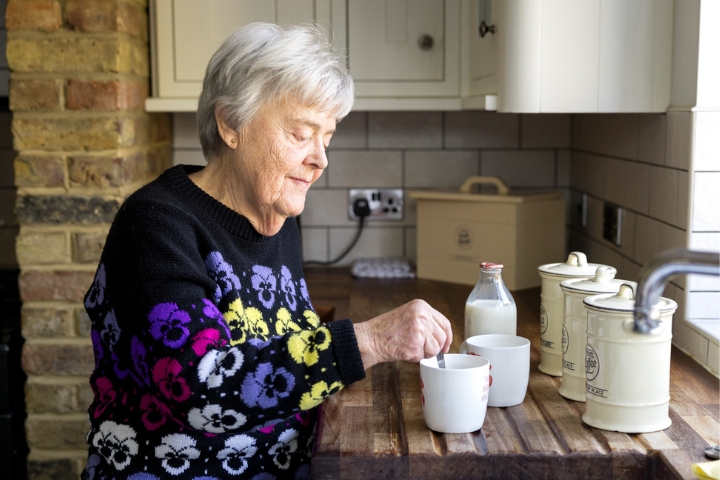At Radfield Home Care, we understand how emotionally complex it can be to decide on the right care for someone you love. Every family is different, and so are the journeys that bring people to consider live in care. Whether you’re caring for ageing parents at home or exploring new options for someone whose needs are evolving, this guide is here to support you with clarity, compassion and practical advice.
Live in care can offer a truly life-enhancing solution; personalised support that allows people to remain in the home they know and love, while receiving the care they need to live safely, comfortably and independently. But is live in care right for your parents or your family member? Let’s explore together.

Signs it might be time to consider Live in Care
Every person’s circumstances are unique, but there are some common signs that you may need live in care that can help guide your thinking.
Introducing support early; Before it is urgent
Many families wait to consider care until after a crisis – perhaps a fall, hospital stay or the onset of rapid decline. But at Radfield, we believe care shouldn’t be driven by panic. The first step is to talk about care as sooner rather than later. Introducing a live in companion early, even before domiciliary visits are required, can be a proactive step that maintains independence for longer.
Perhaps your loved one is still relatively independent, going out regularly, enjoying hobbies and managing day-to-day life well. But if you’re finding it difficult to be there as often as you’d like, whether for appointments, companionship, or shopping trips, a Care Professional can gently step into that space. Their presence can add consistency, social connection, and subtle reassurance, all of which can help support wellbeing and confidence over time.
Many families tell us that the continuous emotional support, nutrition, engagement and structure provided by a live in Care Professional helps slow the pace of change.
This early approach is about enhancing life, not responding to decline. It’s about making space for joy, connection and continued independence; while gently preparing for the future.
Increased care needs or safety concerns
Of course, for some families, care becomes necessary due to more obvious changes; mobility challenges, memory concerns or increasing reliance on others for personal care. These are also valid and important moments to consider when to transition to 24-hour care. If your loved one is struggling with basic tasks or showing signs of confusion, agitation or forgetfulness, 24-hour support may offer both safety and peace of mind.

Comparing care options: Live in care vs hourly visits vs care homes
Choosing between care at home and care homes involves considering personal preferences, care needs, costs and emotional impact. Here’s how different types of care compare
Hourly home care
Hourly or visiting care involves a Care Professional coming to the home at set times during the day to provide support. It’s a flexible option that works well when needs are lower or moderate, such as help with meals, medication or housekeeping. However, when care needs increase, multiple visits may not provide enough continuity or emotional presence.
Live in care
Live in care provides a consistent one-to-one service with a dedicated Care Professional living in the home. It allows for 24-hour oversight, ongoing companionship, and a fully tailored daily routine. For families who wish to avoid disruption, moving away from home, or the impersonal nature of some larger care environments, live in care offers a reassuring alternative.
Even when full support isn’t yet needed, a live in companion can play a vital role. From joining someone on walks, to preparing favourite meals, or ensuring medication is taken correctly, their presence supports independence while building a trusted relationship for the future.

Residential care homes
While care homes suit some people, they often require a major lifestyle shift. Leaving behind a beloved home, pets or community can be difficult. In contrast, live in care allows people to retain all that is familiar and meaningful, while receiving personalised support.
Real stories: When families choose live in care
We’ve supported many families through different stages of the care journey. Here are two anonymised examples to illustrate how live in care can adapt to individual needs and be introduced in a way that preserves independence and enhances daily life.
Case study 1: Compassionate continuity after loss
When Alan was first admitted to hospital, we supported him at home with regular domiciliary visits after his discharge. He was the primary carer for his wife, Margaret, who was living with late-stage dementia. After Alan sadly passed away, Margaret was left alone, grieving, and needing consistent support. Her family lived far away and couldn’t be with her every day. We introduced a live in Care Professional who provided companionship, helped with meals, medication, household tasks, and accompanied her on community outings – from garden centre visits to walking the dog. The stability and company helped Margaret through her bereavement while maintaining her independence in her own home. Her mood and well being have noticeably improved, and she continues to live life with warmth and routine.
Case study 2: Restoring family roles with tailored support
Edward is a highly independent and intellectually active man who lives with his adult son. Over time, his son found himself in a full-time caring role, which began to blur the line between being a son and being a carer. To reduce the strain and support Edward’s mobility need, particularly his risk of falling, we introduced a live in Care Professional. They now assist with safe movement around the home, medication, meals, and domestic tasks. Crucially, they also built strong relationships with both father and son. With this tailored support in place, Edward continues to enjoy his passions, making marmalade, attending weekly art classes, and storytelling, while his son has been able to step back into his role as a son, knowing his father is well cared for.
Decision checklist: Is Live in Care right for your family?
We’ve created this quick checklist to help you reflect on whether live in care could be the right option for your loved one; even if only as a first step into companionship.
It may be the right time to explore live in care if:
- You worry about them being alone, especially at night.
- You live at a distance and can’t always be there.
- They’d benefit from more companionship and routine.
- They are increasingly relying on family or neighbours.
- Their current care is starting to feel disjointed or insufficient.
- They’ve had a recent fall, hospital stay, or decline in confidence.
- They have a condition that is likely to progress.
- You want to plan ahead, not react to a crisis.
Remember, live in care doesn’t have to be a permanent or full-time arrangement – many families begin with respite support or short-term companionship care, giving themselves a break or trying out the service before deciding what level of care is right for the future.

Let’s talk; No obligation, free consultation
At Radfield Home Care, we believe in thoughtful, proactive conversations around care; not reactive decisions made in a hurry. If you’re wondering whether now is the right time, let’s talk it through.
We’ll help you explore the options, understand what’s available, and decide what makes the most sense for your family; both now and in the future.
Contact your local Radfield office today to arrange a free care consultation, and let’s start planning care that keeps your loved one connected to what matters most.